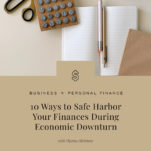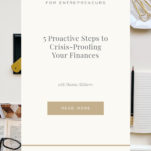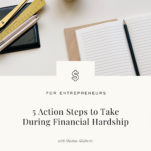Keep Reading
10 Ways to Safe Harbor your finances during economic downturn
It’s official. Covid-19 is currently topping the charts of my google search box. These past few weeks have been a whirlwind often leaving me swinging precariously on a pendulum from panic to peace, fear to faith. As many of us have jokingly (or not so jokingly) panicked over the toilet paper shortage… what’s less visible […]

Paragraph
It’s official. Covid-19 is currently topping the charts of my google search box. These past few weeks have been a whirlwind often leaving me swinging precariously on a pendulum from panic to peace, fear to faith. As many of us have jokingly (or not so jokingly) panicked over the toilet paper shortage… what’s less visible on social media are the late night kitchen table talks by families all over the world wondering “how are we going to financially survive this?”
This crisis stretches beyond my chai tea mix currently out of stock at every grocery store in our town (insert heavy sigh + teenager style eye roll) as well as the very real concern for my 87 year old grandmother who lives alone. I think it’s safe to say we are all afraid in one way or another. While I cannot take those fears away, I want to share some things Kyle and I have learned in our financial journey about CRISIS PROOFING YOUR FINANCES.
Our first “crisis” came back in 2011 just six months after getting married. We found ourselves jobless in a new city, beyond broke, and not sure how to make ends meet. You can read more about that story, here. We learned a lot during that season, too much to recount in one blog, but our life-altering takeaway from overcoming financial hardship was this: always account for life change.
If we were sitting down to coffee, six feet apart of course in separate cars of course after grabbing Starbucks through the drive-through window of course, I’d look at you and say – please don’t be hard on yourself for your financial fears. Don’t make a list of “I wish I had”. Believe me, I’ve been there. Instead take this Maya Angelou quote to heart,
“Forgive yourself for not knowing what you didn’t know before you learned it.”
MAYA ANGELOU
As I sat down to write about Crisis-proofing your finances, I thought really what you probably need more than a list of financial to-dos is a way to immediately respond to the crisis you’re currently in. Crisis-proofing will come, crisis-response is now.
Bookmark these first five steps under “Don’t panic. Make a plan!”
For every small business owner cash flow is the name of the game…always. We need more cash coming in each month than cash going out (or atleast breakeven!). During times of financial crisis cash flow gets tight (or non-existent) which threatens our ability to survive. In times of financial hardship the question to ask yourself is this : “what do I have to do to keep the lights on?”
The goal during times of crisis is to stay CASH FLOW POSITIVE. Cash flow ensures survivability. What is required in order to stick around until the crisis passes? Longevity is key. This may not be your record setting year, but sticking around gives you the opportunity to set new records next year!
FIVE ACTION STEPS TO TAKE DURING FINANCIAL HARDSHIP
1.
Understand your NEED.
What is the bare minimum amount needed each month to keep your business and household running? Bare Minimum. We’re talking about the “keep the lights on and that’s about it” number.
If you aren’t sure, print off your previous month bank statement and go through it line by line.
- First separate expenses into personal expenses versus business-related expenses (if you don’t have separate accounts).
- From there, group your spending by category. Ie: rent, utilities, software subscriptions, payroll, etc.
- Third, add up the total in each category as well as the total amount of all categories. At the end you should have two numbers : your monthly “need” as well as your annual “need”.
For instance, I know that my business needs $16,000 a year (not including my salary or taxes) to run in 2020 while I’m on sabbatical. I spend $500 per month on general expenses ($500 x 12 = $6,000 annually). Plus an additional $10,000 throughout the year which includes annual fees for subscriptions or paying my accountant to file taxes. These expenses don’t happen every month but I don’t want to forget them!
Monthly Need + Annual Fees = Total Annual Need (calculate separately for business and personal)
2.
Create an Income Snapshot
Review the income coming in each month as well as the cash reserves you currently have on hand and create a snapshot of all the income you expect to receive in the next 3-6 months.
For Business : look at invoices due, recurring payments from clients, and other revenue streams that you feel are secure. Also, look to see if you have any income that is currently booked but may be lost due to the current or upcoming circumstances (ie. Events postponed due to Covid-19, launches moved, clients no longer able to afford recurring subscription, etc.)
For Personal : what other sources of income do you have available that do not rely on your business? For instance, does your spouse work? Do you have rental property income? Etc.
Last : What cash reserves (ie. emergency fund) do you have personally and for the business. For example: we have an emergency fund, as well as a tax savings account, and also a renovation budget (we are currently renovating our home). If we were in a financial bind I would look at all the sums of money we have saved and see if postponing renovations or using our emergency fund makes sense to float us through a few months when business income is scarce.
3.
Make a plan to breakeven.
Take this time to look over all sources of income plus any cash reserves you have on hand and determine if your income exceeds your expenses or if you foresee not having enough income in the coming months to cover your expected expenses (both business-wise and personally).
The fancy name here would be a “cash flow plan”. What’s coming in? What’s going out?
If you find yourself short on cash, here are your next steps :
- Determine how much additional income is needed to cover both business and personal needs for the next 3 months? Next 6 months? I like having a 3-month plan as well as a 6-month plan just in case!
- What are some creative ways to bring in this money? Think outside the box here. Maybe it’s taking on a second job (no shame in that game, we’ve all done it!) Or selling some “non-portfolio” work (also no shame in that game, we’ve all done it!) Remember, the key is getting through this current season in order to have the opportunity to build a solid foundation for the future.
DOWNLOAD THE FREE GUIDE : COVID-19 FINANCIAL RELIEF RESOURCES.
I put together 50 Financial Relief Resources for your home and business (no opt-in required) to help keep more money in your pocket and stay cash flow positive to get through this season of uncertainty. Click Here to Download the Free Guide (no opt-in required).
4.
Spend with Intention
Hold on to your cash until the crisis settles!!! Do this by evaluating every dollar being spent and spend with intention and purpose.
Don’t be surprised if in this season you need to cut back on spending. Here are four creative ways to decrease your monthly need. Please remember: these nice to haves can absolutely be resumed once cash is more available. Doing the hard thing now will set you up for a brighter and more secure financial future. This is just a season, not forever!
- Cut back (or stop all together) extra payments on loans. Believe me aggressively tackling debt is one of my favorite things, but when cash reserves need to be stretched these aggressive debt reduction goals may need to subside for a while. ie. Additional mortgage payments, student loans, auto payments, even putting money into long-term savings may need to be put on hold for a bit (such an unpopular opinion ?).
- Evaluate spending on entertainment costs such as cable or paid programming like audible. Consider cutting back to one or two, or replacing paid programming completely with a free option!
- Cancel any subscription services that aren’t currently being utilized.
- I cringe to mention this one, but paying minimum payments on credit cards instead of paying cards off in full each month. Again, only during a time when cash reserves need to be stretched.
5.
Play the Long Game.
In times of financial hardship, don’t be afraid to ask for help or supplement your income with “non-portfolio” work. Cash is cash. No matter what the source, it will pay the bills! Remember, sticking around is the key! Play the long game, do what it takes now to ensure you can be here tomorrow. When Kyle and I really started pursuing entrepreneurship, we both took major pay cuts to do it. We had to relearn what it looks like to live on a budget. Many months our income didn’t cover our expenses so we both worked multiple jobs to make ends meet. Did I see myself cleaning floral studios for a living, no! But, it got us through. We transformed the way we manage money (which is why I’m so passionate to talk about it today) and now have a solid financial future.
I have a few additional resources I would love to share :
-
- Our journey to financial freedom audio blog : https://shannaskidmore.com/get-out-of-debt-financial-freedom/
- COVID-19 FINANCIAL RELIEF RESOURCES. 50 Financial Relief Resources for your home and business (no opt-in required). Click Here to Download the 20-page Guide.
- THE CASH FLOW BLUEPRINT: A second free guide with exclusive content on managing debt in times of financial uncertainty, paying yourself consistently even with fluctuating income, & my #1 trick to easily stick to a budget. Create predictability in your finances and a solid financial foundation with my Cash Flow Blueprint. Download your free copy, here.
Create predictability in your finances and a solid financial foundation with my Cash Flow Blueprint.
Download my financial survival guides to gear your business during these uncertain times.
–
Once you’ve made it past the season of financial hardship, trust me you will, it’s time to start Crisis-Proofing your finances. The goal of these next steps is to create predictability in your finances and a solid foundation for the future.
FIVE PROACTIVE STEPS TO CRISIS-PROOF YOUR FINANCES
1.
Have 3-6 months of cash reserves for both business and home
2.
Live below your means.
I know, I know… you hear this all the time. But in order to not feel strapped every month you have to live in the margin! Margin is the leftover; the difference between what is coming in and what is going out. This strategy is what accounts for life change and in turn crisis-proofs your finances!
3.
Create a spending plan for your finances.
As my favorite Dave Ramsey quote goes “tell your dollars where to go instead of wondering where they went.” Some call this a budget but I think “budget” sounds more like a six-letter curse word! Instead I call it a spending plan. A plan that gives permission to spend, instead of a budget which feels restrictive!
4.
Stay Cash Flow Positive.
What is coming in? What is going out? Cash Flow Positive (more in than out) is the goal!
5.
Name Your Money Values
One of the key steps I think is often left out of financial planning is this: start by identifying your individual money values. Each of us value different things. ie. some of us value interior decor (ahem, me!) while some of us value big expenses woodworking tools (hello, Kyle!). Each of us are willing to spend money on what we value. To create a successful money plan, one we actually want to live by long-term, It’s important to name our values (especially if they differ from those in our household!).
–
Clearly, there is a lot more to say about this topic but I hope this was a good start! These 10 steps will gear your business with an action plan to respond to financial hardship and then prepare for crisis-prevention in the future! Make sure to download the free financial survival guides to dig deeper into this conversation!
DOWNLOAD THE FREE (2-Part) FINANCIAL SURVIVAL GUIDE SERIES : Over 30 pages of FREE FINANCIAL CONTENT
This too shall pass.
Cheering you on always,
Shanna
*Want to save this to read later? Click the red button below to Pin it 
April 1, 2020
Previous Post:
Next Post:
And if you found this helpful, share with your friends!







I’ve shared this with so many people who are freaking out around me, and they’ve found it helpful (and calming) haha. I’m not in their boat since I crisis “proofed” already… thought it would be because of a freak accident like breaking my foot and being unable to work. But nope… it was a worldwide pandemic. The stories we’ll be able to tell our grandkids when this is all over, right?
Lauren, Thank you so much for sharing with your friends. I’m so grateful to hear it has been helpful to so many! Also, thanks for sharing your success story of safe-harboring your finances to prepare for the unexpected. I have no doubt that is encouraging for others to know it’s absolutely possible! xx, Shanna